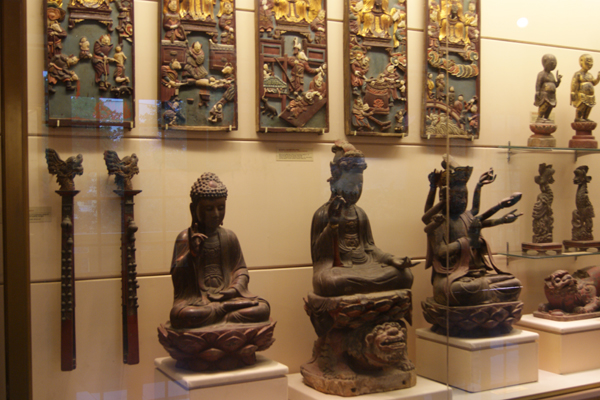Dong Ho painting paper is handmade from the bark of a tree called do which is normally grown in Tuyen Quang Province, according to a Che’s daughter.
The bark of the do is stored in the water for months, then strengthened with a mix of sea shells and sticky rice.nguyen art gallery
The paint is applied to the woodblock and pressed on a paper like a stamp. The process is repeated with different colours to complete a painting.
Before the August Revolution, Dong Ho Village was well-known for making votive objects and Dong Ho paintings, according to Che. He explained that Dong Ho paintings used to be a must in every Vietnamese household for Tet, Lunar New Year.
With the chaos of war and the difficult times that followed, more than 100 families who made the paintings quit their traditional jobs.
The village now concentrates on making votive objects. Having retired in 1991, Che thought about reviving Dong Ho paintings.
It took him five years to find the ancient wood-blocks,as only 11 families in the village still holding on to them.
“It’s difficult to convince some families in the village who don’t want to sell the wood-blocks. They only agreed when I told them I was working in conservation.
Many other families were easier to convince because they wanted the money,” said Che. By 1994, he had collected around 200 wood-blocks.
Since he kicked off his business in 1995, Che’s been doing pretty well selling Dong Ho paintings. Customers often ask to come to his house to see the ancient paintings, wood-blocks and the painting process.
He used to welcome a group of Japanese who lived in the village for nearly three months to understand Che’s work.
This is what made him consider opening a museum to introduce Dong Ho paintings The collection is sitting in Song Ho Commune. The showroom includes three big traditional houses with five compartments each.
One house will serve as a guest house, another for selling paintings and the last was supposed to be where the paintings would be viewed, however, it has yet to be completed due to a lack of funds, Che said.
The 5,000sq.m showroom is part of a 11,000sq.m pond which Che leased from Bac Ninh Province for 50 years. He has now built up around half the pond.
He refuses to reveal where his money comes from. “The people ask where the billion of dong comes from?… It’s all my savings,” Che said. Now Che now has nearly 100 ancient wood-blocks between 50-100 years old. One of the blocks is nearly 400 years old, and has been handed down through nine generations.
He is proud of these ancient Dong Ho paintings. “Some people want to buy them, offering thousands of dollars. I don’t agree because I want to preserve the tradition,” Che said.
Classic Dong Ho paintings use natural materials as colours, Che said proudly. The colours of the painting are refined from various kinds of materials which are easily found in Viet Nam.
The red colour is taken from red gravel in Thien Thai Mountain and the black colour comes from the coal of burned straw. Another characteristic of Dong Ho paintings is the durability of colours.
These days, many Dong Ho paintings are indust-rialised, with the use of industrial colours. “I forbid my family to do that, because the paintings will not be long lasting,” Che said.
His family is now welcoming tourists who want to know about the traditional method to make the paintings. Che is now looking for financial support from donors to complete his final showroom. — VNS



